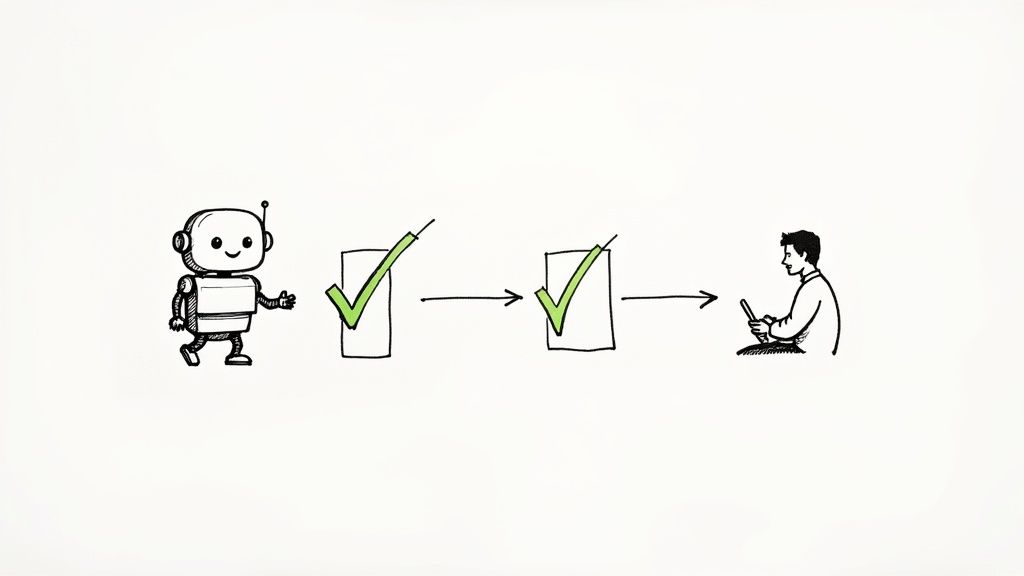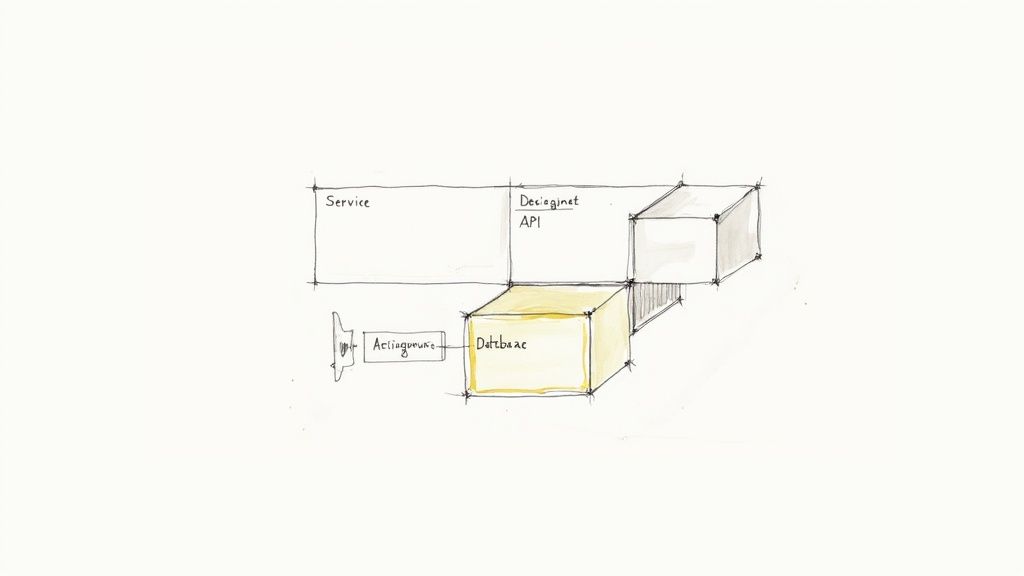10 Code Review Best Practices for Elite Dev Teams in 2025
Max
Code reviews are a critical pillar of modern software development, but they often become a dreaded bottleneck-a source of friction, delays, and interpersonal tension. When implemented poorly, the process feels like a chore. However, when executed effectively, code reviews transform into a powerful engine for improving code quality, sharing knowledge, and fostering a collaborative engineering culture. High-performing teams understand that mastering this process is non-negotiable for building robust, maintainable software.
This guide moves beyond generic advice to provide a deep dive into specific, actionable code review best practices that you can implement immediately. We will cover ten proven strategies that turn the review process from a necessary evil into a competitive advantage. You will learn how to structure smaller, more effective reviews, leverage automation to catch errors early, and cultivate a positive feedback loop that builds both better software and stronger developers.
By adopting these principles, you can streamline your development lifecycle, reduce bugs in production, and elevate the skills of your entire team. Let’s explore how to make your code review process a superpower, not a slowdown.
1. Keep Reviews Small and Focused
One of the most impactful code review best practices is to limit the size of each review. Large, sprawling pull requests (PRs) or merge requests (MRs) overwhelm reviewers, leading to high cognitive load and a significant drop in the quality of feedback. When a reviewer is faced with thousands of lines of changes, they are far more likely to skim the code, miss subtle bugs, and provide superficial comments rather than a thorough analysis.

This principle is validated by industry leaders. Research from companies like Google and findings published in O’Reilly’s Modern Code Review have shown that reviewers’ ability to spot defects diminishes sharply after about 400 lines of code. Keeping reviews small and focused on a single logical change makes the process faster, less fatiguing, and dramatically more effective.
Why It Works
Small reviews create a positive feedback loop. The author receives higher-quality, more actionable feedback, and the reviewer can complete their task quickly without context-switching fatigue. This approach encourages incremental development, making it easier to pinpoint the source of a bug if one is introduced.
“Reviewing anything over 400 lines of code is a waste of time. At that point, you’re just spot-checking.”
How to Implement This Practice
- Break Down Large Features: Decompose complex features into smaller, logical, and independently reviewable commits. Each commit should represent a single, atomic change.
- Use Feature Flags: Merge incomplete but functional pieces of a larger feature behind a feature flag. This allows for continuous integration and review without exposing unfinished work to users.
- Set Clear PR Guidelines: Establish team-wide standards for PR size. Aim for a soft limit of 200-400 lines of code, but focus more on the conceptual size of the change. A 100-line change that alters core logic requires more attention than a 300-line change adding new configuration files.
2. Establish Clear Code Review Standards and Checklists
To make code reviews objective and consistent, teams must move beyond subjective opinions and establish clear, documented standards. Creating a formal set of guidelines and checklists ensures that every piece of code is evaluated against the same criteria, regardless of who writes it or who reviews it. This practice transforms the review from a potential source of conflict into a collaborative process focused on quality and adherence to agreed-upon principles.
These standards typically cover everything from coding style and formatting to architectural patterns, security vulnerabilities, and performance considerations. By documenting these expectations, you create a single source of truth that streamlines onboarding for new developers and reduces ambiguity for seasoned engineers, making it a cornerstone of effective code review best practices.
Why It Works
Clear standards remove the guesswork from code reviews. Reviewers no longer have to rely on memory or personal preference; they can refer to a concrete document. This objectivity minimizes “style wars” and focuses feedback on meaningful improvements. Authors receive predictable, consistent feedback, which helps them learn and internalize team conventions more quickly.
“Without a checklist, reviews are just a series of random suggestions. With one, they become a systematic quality gate.”
How to Implement This Practice
- Document Your Style Guide: Adopt and document a language-specific style guide, like Airbnb’s JavaScript Style Guide. Use automated linters and formatters to enforce these rules automatically before the review even begins.
- Create PR Templates with Checklists: Embed a checklist directly into your pull request templates on platforms like GitHub or GitLab. This forces authors and reviewers to confirm that key requirements (e.g., tests are written, documentation is updated, security scans passed) have been met.
- Define Architectural Principles: Document your core architectural patterns, data models, and technology choices. This helps reviewers ensure new code aligns with the system’s long-term vision.
- Review and Update Standards Regularly: Your standards should be a living document. Schedule quarterly or bi-annual reviews to update guidelines based on new technologies, lessons learned, and team feedback.
3. Implement Automated Checks Before Human Review
Human reviewers are most valuable when they focus on the logic, architecture, and intent behind the code. One of the most effective code review best practices is to offload the repetitive, objective tasks to automated tools. By integrating linters, formatters, static analysis, and security scanners into your CI/CD pipeline, you can catch common issues like style violations, syntax errors, and potential bugs before a human ever sees the code.

This “robots first, humans second” approach is a cornerstone of modern development workflows, championed by tech giants like Netflix and Twitter. It streamlines the review process by eliminating debates over trivial matters like indentation or comma placement, allowing reviewers to concentrate on higher-level concerns that automated tools cannot assess.
Why It Works
Automation acts as a quality gatekeeper. It ensures that every pull request meets a baseline standard of quality and consistency before it enters the human review phase. This saves time for both the author and the reviewer, reduces friction, and enforces standards impartially, which is a key part of wider software development best practices.
“Automate everything that can be automated. Let humans focus on what they do best: understanding context and providing insightful feedback on complex logic.”
How to Implement This Practice
- Integrate Linters and Formatters: Use tools like ESLint, Prettier, or RuboCop in a pre-commit hook or as a mandatory step in your CI pipeline to enforce coding style automatically.
- Leverage Static Analysis: Employ tools like SonarQube or CodeClimate to detect code smells, potential bugs, and security vulnerabilities early in the process.
- Fail the Build on Critical Issues: Configure your CI pipeline to fail if critical automated checks do not pass. This prevents code with known issues from ever reaching the review stage.
- Keep Rule Sets Maintainable: Start with a standard, widely accepted ruleset and customize it carefully. Avoid adding hundreds of niche rules that create more noise than value.
4. Use Positive and Constructive Communication
One of the most crucial code review best practices is to foster a culture of collaborative improvement rather than personal criticism. The goal of a code review is to improve the codebase, not to find fault with the author. Adopting a positive and constructive communication style ensures that feedback is received as helpful guidance, strengthening team trust and psychological safety.

This approach is championed by engineering cultures at companies like Etsy and Google, whose internal guides emphasize empathy and respect. The focus shifts from pointing out mistakes to collectively building better software. When feedback is framed constructively, developers are more likely to engage with it openly, leading to better code quality and a more positive and productive engineering environment. This is a core part of improving workplace communication within technical teams.
Why It Works
Positive communication depersonalizes feedback. It separates the code from the coder, allowing for objective discussion about technical merits without making the author feel defensive. This creates a safe environment where developers feel comfortable taking risks and learning from their peers, which is essential for innovation and growth.
“Always be respectful and kind in your reviews. Remember that you are critiquing the code, not the person who wrote it.”
How to Implement This Practice
- Ask Questions, Don’t Make Demands: Instead of saying “Change this logic,” ask “Could you help me understand the reasoning behind this approach? I’m wondering if X might be a simpler alternative.”
- Use ‘I’ Statements: Frame feedback from your perspective. “I found this part a bit hard to follow” is more collaborative than “This is confusing.”
- Acknowledge Good Work: Start reviews by highlighting something you liked. Comments like “Great job on this complex logic!” or “I really like how you handled this edge case” build rapport and make constructive feedback easier to accept.
- Suggest Alternatives: When you identify an issue, try to propose a concrete solution or alternative. This shows you’re invested in finding a solution together, not just pointing out problems.
5. Require Tests for All Code Changes
One of the most critical code review best practices is to mandate that every code change is accompanied by corresponding tests. Whether they are unit, integration, or end-to-end tests, this practice ensures that new code is verifiable, maintainable, and less likely to introduce regression bugs. By making testing a non-negotiable part of the development cycle, teams shift from hoping code works to proving it does.
This principle is a cornerstone of modern software engineering, championed by the Test-Driven Development (TDD) movement and enforced by major tech companies like Google and Microsoft. Requiring tests moves the focus from a purely subjective review of the code’s logic to an objective verification of its behavior. It transforms the review process into a collaborative effort to build a more robust and reliable codebase.
Why It Works
Enforcing tests with every change builds a safety net that catches bugs before they reach production. It documents the intended behavior of the code, making future modifications safer and easier to reason about. This practice also forces developers to write more modular and decoupled code, as tightly coupled code is notoriously difficult to test.
“Code without tests is broken by design.” - Jacob Kaplan-Moss
How to Implement This Practice
- Set Clear Coverage Goals: Aim for a realistic test coverage target, typically between 70-80%. Striving for 100% can lead to diminishing returns and low-value tests.
- Review Test Quality: Don’t just check for the existence of tests; review their quality. Ensure they cover edge cases, are not brittle, and accurately reflect the code’s requirements.
- Mandate Tests for Bug Fixes: A bug fix is not complete until it includes a regression test that fails without the fix and passes with it. This prevents the same bug from reappearing.
- Automate Enforcement: Use CI/CD pipeline tools to automatically check for test coverage and block merges that fall below the established threshold.
6. Promote Knowledge Sharing and Mentoring
Viewing code reviews solely as a gatekeeping mechanism to catch bugs is a missed opportunity. One of the most valuable code review best practices is to transform the process into a platform for knowledge sharing and mentorship. Instead of just pointing out errors, senior developers can use reviews to explain architectural decisions, introduce new patterns, and guide junior colleagues, while junior developers can ask clarifying questions that challenge assumptions.
This approach treats every pull request as a learning artifact. Companies like Shopify foster this through their “shipit” culture, where learning and iteration are core components of the development cycle. Similarly, open-source communities like Python and Linux have long used the review process as their primary method for mentoring new contributors, ensuring that institutional knowledge is passed down and standards are maintained organically.
Why It Works
This practice builds a resilient, knowledgeable, and collaborative team. It breaks down knowledge silos, ensuring that more than one person understands critical parts of the codebase. For junior developers, it provides direct, contextual mentorship that accelerates their growth far more effectively than any training course. It also improves code quality long-term by elevating the entire team’s skill level.
“A code review is a dialogue, not a judgment. The goal is to improve the code and the developers who write it.”
How to Implement This Practice
- Explain the ‘Why’: When suggesting a change, don’t just say what to fix. Explain why the alternative is better, linking to documentation, style guides, or architectural decision records.
- Pair Developers: Intentionally pair a senior developer with a junior developer for reviews. This creates a dedicated mentorship channel within the natural workflow.
- Encourage Questions: Foster a psychologically safe environment where authors feel comfortable asking questions about feedback rather than just blindly accepting it.
- Host ‘Code Review Sessions’: Periodically review a recent, interesting PR as a team. Discuss the changes, the feedback, and the thought process behind the decisions made.
7. Set Realistic Time Expectations and SLAs
One of the most common bottlenecks in the development lifecycle is code sitting idle while waiting for a review. Establishing clear Service Level Agreements (SLAs) for review turnaround times is a critical code review best practice that prevents this limbo and maintains development velocity. When developers know when to expect feedback, they can plan their work more effectively, and the entire team benefits from a predictable, rhythmic workflow.
This practice is championed by numerous high-performing tech companies. Google, for instance, aims for a review turnaround time of under 24 hours, while teams at AWS often use priority-based SLAs where an urgent fix might have a 4-hour target. These expectations ensure that critical work isn’t blocked and that momentum is sustained across the board.
Why It Works
Clear time expectations reduce friction and anxiety in the development process. Authors aren’t left wondering if their work has been forgotten, and reviewers can better manage their time by understanding the priority of incoming requests. This formalizes an often-informal process, making it a reliable and efficient part of the workflow, which is especially important for distributed teams. For insights into managing such processes effectively, explore how to manage remote teams.
“Without an SLA, code review is just a queue with no guarantee of service. It becomes a black hole for productivity.”
How to Implement This Practice
- Establish a Team-Wide Goal: Agree on a standard turnaround time for most reviews, such as one business day. This sets a clear, measurable benchmark.
- Define Priority Levels: Create a system for flagging urgent or high-priority reviews that require a faster response, such as hotfixes or blocker-clearing changes.
- Use Automation: Leverage tools like GitHub’s CODEOWNERS file or Slack bots to automatically assign reviewers and send reminders, ensuring no PR falls through the cracks.
- Rotate Reviewer Duties: To prevent burnout and knowledge silos, rotate the primary reviewer role. This distributes the workload and exposes more team members to different parts of the codebase.
8. Focus on Architecture and Design in Reviews
While linters and automated tools can catch style violations, a human reviewer’s greatest value lies in evaluating high-level architectural and design decisions. One of the most critical code review best practices is to shift focus from minor stylistic nits to the fundamental structure of the change. Reviewers should assess how the new code integrates with the existing system, whether it adheres to established design patterns, and if it introduces any long-term maintenance risks.

This approach ensures that code reviews serve as a strategic checkpoint for system integrity, not just a proofreading exercise. Companies like Netflix and Uber prioritize this by focusing reviews on how changes impact their distributed systems. They evaluate API contracts, service boundaries, and data flow to maintain a robust and scalable architecture.
Why It Works
Focusing on architecture prevents “death by a thousand cuts,” where small, individually acceptable changes gradually erode the system’s design integrity. It encourages developers to think holistically about their work’s impact, fostering a culture of shared ownership over the system’s health. When conducting code reviews, particularly in distributed systems, understanding and adhering to solid architecture principles is vital. You might find insights into effective design in discussions on microservices architecture best practices.
“Good architecture makes the system easy to understand, develop, and maintain. Code reviews are the first line of defense for that architecture.”
How to Implement This Practice
- Ask Big-Picture Questions: Frame feedback around questions like, “Does this change align with our target architecture?” or “How will this scale under heavy load?”
- Evaluate System Interactions: Consider the change’s impact on other services, its backward compatibility, and the clarity of its API contracts.
- Discuss Trade-offs: Encourage discussions about the design choices made. Acknowledge that there are often multiple valid solutions and focus on selecting the one that best fits the system’s long-term goals.
- Leverage Documentation: Refer to system diagrams and architectural decision records (ADRs) during the review to ensure the change is consistent with documented plans.
9. Document Decisions and Create Review Records
A code review’s value extends far beyond the immediate bug fix or feature merge. One of the most critical code review best practices is to treat the review thread as a living document. Maintaining detailed records of discussions, decisions, and the rationale behind them creates invaluable institutional knowledge, provides context for future developers, and prevents the team from re-litigating the same architectural debates.
This practice transforms transient conversations into a permanent, searchable knowledge base. When a developer six months later wonders why a specific implementation was chosen over another, the answer is right there in the pull request history. Companies like Microsoft and Spotify formalize this by linking pull requests to Architecture Decision Records (ADRs) or Confluence pages, ensuring major decisions are captured for the long term.
Why It Works
Documenting decisions provides crucial context, which is often lost over time as team members change. It helps onboard new engineers, justifies technical choices to stakeholders, and serves as a reference point when refactoring or extending code. This clarity reduces future development friction and prevents the loss of critical design rationale, which is essential for maintaining a healthy and evolving codebase.
“The ‘why’ behind a code change is often more important than the ‘what.’ Without it, future developers are flying blind.”
How to Implement This Practice
- Summarize Complex Threads: Before merging, the author or a key reviewer should post a summary comment that outlines the major discussion points, the final decision, and the reasoning behind it.
- Document the “Why”: Focus on capturing the rationale for a decision, not just the outcome. Explain the trade-offs considered and why the chosen path was the best option at the time.
- Use Architecture Decision Records (ADRs): For significant architectural changes, create a lightweight ADR and link it in the PR. This formalizes the decision-making process for high-impact changes.
- Tag Key Decisions: Use labels or tags (e.g.,
decision-record,architecture) in your version control system to make important discussions easily searchable in the future. For more insights on this topic, learn how to write effective technical documentation.
10. Maintain Reviewer Diversity and Rotation
A common pitfall in the code review process is relying on the same one or two senior engineers to review all changes. This creates a significant bottleneck, slows down the development cycle, and concentrates knowledge within a small group. One of the most effective code review best practices is to deliberately diversify and rotate reviewers to distribute the workload and foster a culture of collective code ownership.
Involving a mix of reviewers with varied expertise, such as backend, frontend, and QA engineers, brings multiple perspectives to the table. A junior developer might spot an unclear variable name that a senior engineer overlooks, while a QA specialist may identify potential edge cases in the logic. This approach is central to successful open-source projects like the Linux Kernel and Kubernetes, where multiple maintainers and specialists must approve changes, ensuring robustness and quality.
Why It Works
Rotating reviewers prevents knowledge silos and ensures that more team members are familiar with different parts of the codebase. This practice also promotes a more inclusive and collaborative environment, empowering every team member to contribute to code quality. By sharing the responsibility, teams can avoid reviewer fatigue and ensure that fresh eyes are always looking at the code, leading to better bug detection and higher-quality software.
“When only one person understands a critical system, you don’t have a senior engineer; you have a single point of failure.”
How to Implement This Practice
- Use
CODEOWNERSFiles: Automate reviewer assignments by defining owners for specific parts of the codebase in aCODEOWNERSfile. Platforms like GitHub and GitLab will automatically request reviews from the designated individuals or teams. - Require Cross-Functional Approvals: For significant features, mandate approvals from representatives of different disciplines (e.g., one backend engineer and one frontend engineer).
- Schedule Formal Rotations: Implement a monthly or quarterly rotation schedule to assign primary and secondary reviewers for different projects or microservices. This ensures everyone gets a turn.
- Promote an Inclusive Culture: Encourage team members to proactively request reviews from colleagues outside the usual suspects. This approach aligns well with inclusive leadership principles, which empower diverse team contributions.
10-Point Code Review Best Practices Comparison
| Practice | Implementation Complexity 🔄 | Resource Requirements ⚡ | Expected Outcomes ⭐ | Ideal Use Cases & Tips 💡 |
|---|---|---|---|---|
| Keep Reviews Small and Focused | 🔄 Low — enforce PR/CL size limits | ⚡ Low — short reviewer time per PR | ⭐⭐⭐⭐ — higher defect detection; faster approvals | 💡 Frequent small features; break work into logical commits |
| Establish Clear Code Review Standards and Checklists | 🔄 Medium — create and maintain docs | ⚡ Medium — documentation + automation | ⭐⭐⭐⭐ — consistent quality; fewer subjective disputes | 💡 Large teams, cross-repo work; surface checklists in PR templates |
| Implement Automated Checks Before Human Review | 🔄 Medium — CI and tool integration | ⚡ Medium — compute, configuration, maintenance | ⭐⭐⭐⭐⭐ — catches style/bugs early; reduces human effort | 💡 High-change repos; integrate linting/tests into dev environment |
| Use Positive and Constructive Communication | 🔄 Low — training and example guidelines | ⚡ Low — time to phrase feedback constructively | ⭐⭐⭐⭐ — better morale, more participation | 💡 Teams with juniors; use question-based feedback and praise |
| Require Tests for All Code Changes | 🔄 Medium — testing standards and enforcement | ⚡ High — authoring tests and CI resources | ⭐⭐⭐⭐⭐ — fewer regressions; safer refactoring | 💡 Critical systems/APIs; set realistic coverage targets (60–80%) |
| Promote Knowledge Sharing and Mentoring | 🔄 Medium — structured review/mentorship process | ⚡ Medium — senior reviewer time for teaching | ⭐⭐⭐⭐ — faster skill growth; reduced knowledge silos | 💡 Pair juniors with mentors; link to docs and explain “why” |
| Set Realistic Time Expectations and SLAs | 🔄 Low — define SLAs and escalation paths | ⚡ Low — monitoring and reviewer rotation overhead | ⭐⭐⭐ — predictable flow; risk of rushed reviews if misused | 💡 Distinguish urgent vs normal reviews; respect context switching |
| Focus on Architecture and Design in Reviews | 🔄 High — requires senior expertise and time | ⚡ High — expert reviews and design artifacts | ⭐⭐⭐⭐⭐ — prevents design flaws; reduces long-term debt | 💡 Major features or system changes; review diagrams and trade-offs |
| Document Decisions and Create Review Records | 🔄 Medium — ADRs and comment discipline | ⚡ Medium — documentation effort and storage | ⭐⭐⭐⭐ — preserves institutional knowledge; aids onboarding | 💡 Use ADRs; document rationale and link related discussions |
| Maintain Reviewer Diversity and Rotation | 🔄 Medium — policies and automated assignment | ⚡ Medium — more total reviewer hours across team | ⭐⭐⭐⭐ — broader defect coverage; spreads knowledge | 💡 Use CODEOWNERS and rotate reviewers; include seniors and fresh eyes |
Putting It All Together: Your Path to Better Code
We’ve explored a comprehensive set of ten distinct strategies, each designed to transform your code review process from a simple bug-checking exercise into a powerful engine for quality, collaboration, and growth. Moving from theory to practice can seem daunting, but it’s important to remember that adopting these code review best practices is a journey, not a destination. It’s about cultivating a continuous improvement loop where high-quality code and empowered developers become the norm.
Your Actionable Path Forward
Rather than attempting to implement all ten practices at once, start with a focused approach. Identify the most significant pain points in your current workflow. Are reviews taking too long? Begin by enforcing small, focused pull requests and establishing clear Service Level Agreements (SLAs). Is feedback inconsistent or causing friction? Formalize your standards with a documented checklist and double down on constructive communication training.
By introducing changes incrementally, you allow your team to adapt and internalize each new practice. The foundational combination of automating checks before human review and keeping reviews small often yields the most immediate and substantial improvements. These two habits alone can drastically reduce reviewer fatigue, speed up the development cycle, and free up valuable cognitive resources for focusing on what truly matters: architecture, design, and logic.
The True Impact of Elite Code Reviews
Mastering this discipline is about more than just shipping cleaner code. A world-class review culture fosters a psychologically safe environment where knowledge sharing and mentorship thrive. When junior developers receive thoughtful, constructive feedback, they grow. When senior developers share their architectural insights, the entire team’s expertise deepens. Documenting these decisions creates a living record of your project’s evolution, making onboarding and future maintenance far more efficient.
Ultimately, a robust code review process is a hallmark of a mature engineering organization. It’s an investment in your people, your product, and your processes. It builds a resilient, collaborative, and highly effective team capable of tackling complex challenges with confidence. For a comprehensive overview that brings together many of these concepts, consult a definitive guide to best code review practices which offers further detailed strategies. Embracing these principles is your path to not only building better software but also building a better team.
A strong code review culture is a key indicator of a healthy, high-performing engineering team. Find your next role in an organization that values quality and collaboration by exploring opportunities on Remote First Jobs. Discover companies committed to building exceptional products and fostering developer growth at Remote First Jobs.


